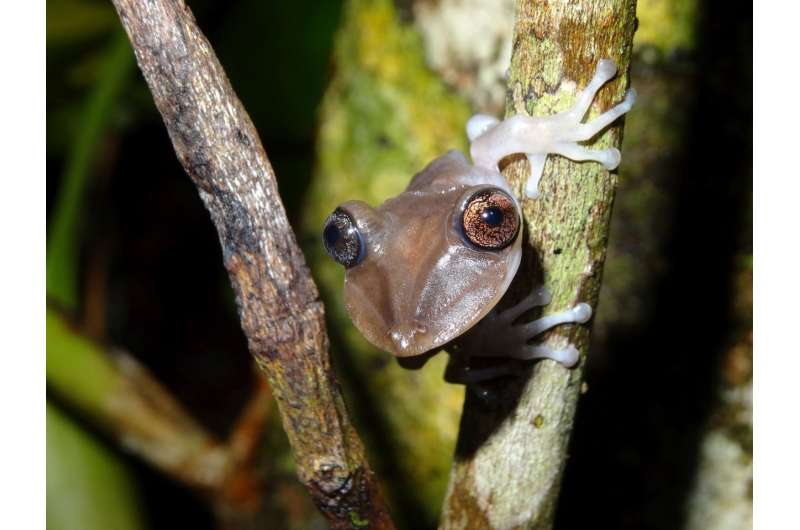Not too big, not too small—tree frogs choose pools that are just right

Frogs that raise their young in tiny pools of water that collect on plant leaves must make a delicate trade-off between the risk of drying out and the risk of being eaten, according to a study publishing December 5 in the open-access journal PLOS ONE by Mirco Solé from the Universidade Estadual de Santa Cruz in Bahia, Brazil and colleagues.
The temporary pools of water trapped by the leaf rosette of some plants in the Bromeliaceae family are used by a variety of creatures as a source of prey, water and shelter—one example is the Broad-snout casque-headed Tree Frog (Aparasphenodon arapapa) which uses the water 'tanks' of bromeliad plants as a place to mate and rear its tadpoles. To understand how the frogs choose the right spot, the researchers measured the characteristics, including size, water level, and leaf debris, of the central tanks of 239 bromeliads in Reserve Boa União in Bahia, Brazil.
They compared bromeliads that were occupied by a tree frog with those that were empty and found that male frogs generally prefer bromeliads with larger tanks, a higher volume of water, and less leaf litter—qualities which make the tanks less likely to dry up and easier to access. However, the very largest and fullest bromeliad tanks were frog-less, suggesting that a trade-off exists when choosing the best place to breed. Males have a specially shaped bony head that they use to form a tight seal with the opening of the bromeliad tank, which is thought to protect them from predators. Forming a tight seal may be tricky in very large bromeliads, making them a poor choice as a shelter.
The authors conclude that the trade-offs animals face when selecting a site to breed should be taken into consideration in conservation strategies.
Solé adds: "Aparasphenodon arapapa, a tropical frog from the Brazilian Atlantic Forest places its eggs into bromeliads, but instead of simply choosing the largest bromeliad tank with the most water, complex trade-offs between selection pressures and balancing water requirements are involved in the bromeliad choice."
More information: Lantyer-Silva ASF, Waldron A, Zina J, Solé M (2018) Reproductive site selection in a bromeliad breeding treefrog suggests complex evolutionary trade-offs. PLoS ONE 13(12): e0207131. doi.org/10.1371/journal.pone.0207131
Journal information: PLoS ONE
Provided by Public Library of Science



















